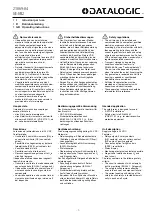
Inrush Restraint
When the multi-functional protective relay with local control 7SJ62/64 is installed, for instance, to protect a
power transformer, large magnetizing inrush currents will flow when the transformer is energized. These
inrush currents may be several times the nominal transformer current, and, depending on the transformer size
and design, may last from several tens of milliseconds to several seconds.
Although pickup of the relay elements is based only on the fundamental harmonic component of the meas-
ured currents, false device pickup due to inrush is still a potential problem since, depending on the trans-
former size and design, the inrush current also comprises a large component of the fundamental.
The 7SJ62/64 features an integrated inrush restraint function. It prevents the “normal” pickup of 50-1 or 51
relay elements (not 50-2 and 50-3) in the phases and the ground path of all directional and non-directional
overcurrent relay elements. The same is true for the alternative pickup thresholds of the dynamic cold load
pickup function. After detection of inrush currents above a pickup value, special inrush signals are generated.
These signals also initiate fault annunciations and start the associated trip delay time. If inrush conditions are
still present after the tripping time delay has elapsed, a corresponding message (
„....Timeout.“
) is
output, but the overcurrent tripping is blocked (see also logic diagrams of time overcurrent elements,
Inrush current contains a relatively large second harmonic component (twice the nominal frequency) which is
nearly absent during a fault current. The inrush restraint is based on the evaluation of the 2nd harmonic
present in the inrush current. For frequency analysis, digital filters are used to conduct a Fourier analysis of all
three phase currents and the ground current.
Inrush current is recognized if the following conditions are fulfilled at the same time:
•
The harmonic content is larger than the setting value 2202
2nd HARMONIC
(minimum 0.125 *
Ι
Nom,sec
);
•
the currents do not exceed an upper limit value 2205
I Max
;
•
an exceeding of a threshold value via an inrush restraint of the blocked element takes place.
In this case an inrush in the affected phase is recognized (annunciations 1840 to 1842 and 7558
InRush
Gnd Det
„InRush Gnd Det“, see
) and its blocking being carried out.
Since quantitative analysis of the harmonic components cannot be completed until a full line period has been
measured, pickup will generally be blocked by then. Therefore, assuming the inrush restraint feature is
enabled, a pickup message will be delayed by a full line period if no closing process is present. On the other
hand, trip delay times of the time overcurrent protection feature are started immediately even with the inrush
restraint being enabled. Time delays continue running with inrush currents present. If inrush blocking drops
out after the time delay has elapsed, tripping will occur immediately. Therefore, utilization of the inrush
restraint feature will not result in any additional tripping delays. If a relay element drops out during inrush
blocking, the associated time delay will reset.
Cross Blocking
Since inrush restraint operates individually for each phase, protection is ideal where a power transformer is
energized into a single-phase fault and inrush currents are detected on a different healthy phase. However,
the protection feature can be configured to allow that not only this phase element but also the remaining
elements (including ground) are blocked (the so-called
CROSS BLOCK
function, address 2203) if the permis-
sible harmonic component of the current is exceeded for only one phase.
Please take into consideration that inrush currents flowing in the ground path will not cross-block tripping by
the phase elements.
Cross blocking is reset if there is no more inrush in any phase. Furthermore, the cross blocking function may
also be limited to a particular time interval (address 2204
CROSS BLK TIMER
). After expiry of this time
interval, the cross blocking function will be disabled, even if inrush current is still present.
The inrush restraint has an upper limit: Above this (via adjustable parameter 2205
I Max
) current blocking is
suppressed since a high-current fault is assumed in this case.
The following figure shows the inrush restraint influence on the time overcurrent elements including cross-
blocking.
2.2.7
Functions
2.2 Overcurrent Protection 50, 51, 50N, 51N
SIPROTEC 4, 7SJ62/64, Manual
69
C53000-G1140-C207-8, Edition 08.2016
Summary of Contents for SIPROTEC 4
Page 8: ...8 SIPROTEC 4 7SJ62 64 Manual C53000 G1140 C207 8 Edition 08 2016 ...
Page 18: ...18 SIPROTEC 4 7SJ62 64 Manual C53000 G1140 C207 8 Edition 08 2016 ...
Page 30: ...30 SIPROTEC 4 7SJ62 64 Manual C53000 G1140 C207 8 Edition 08 2016 ...
Page 540: ...540 SIPROTEC 4 7SJ62 64 Manual C53000 G1140 C207 8 Edition 08 2016 ...
Page 594: ...594 SIPROTEC 4 7SJ62 64 Manual C53000 G1140 C207 8 Edition 08 2016 ...
Page 720: ...720 SIPROTEC 4 7SJ62 64 Manual C53000 G1140 C207 8 Edition 08 2016 ...
















































